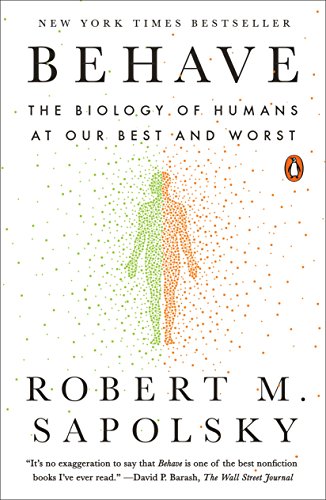![]() Behave: The Biology of Humans at Our Best and Worst by Robert M. Sapolsky
Behave: The Biology of Humans at Our Best and Worst by Robert M. Sapolsky
 Behave: The Biology of Humans at Our Best and Worst (2018), by Robert M. Sapolsky, is, simply put, one of the best non-fiction books I’ve read in years and, had I finished it last year, would absolutely have gone onto my Best of the Year list. Sadly, because I listened to it on audio over several months of commuting, this review will not do it justice in terms of specific references and examples. But to cut an already-brief review even shorter: if you have any interest in other people, yourself, culture, society, or science, buy this book.
Behave: The Biology of Humans at Our Best and Worst (2018), by Robert M. Sapolsky, is, simply put, one of the best non-fiction books I’ve read in years and, had I finished it last year, would absolutely have gone onto my Best of the Year list. Sadly, because I listened to it on audio over several months of commuting, this review will not do it justice in terms of specific references and examples. But to cut an already-brief review even shorter: if you have any interest in other people, yourself, culture, society, or science, buy this book.
Sapolsky wants to explain just why (and also how) we do the things we do, and he structures the book so as to zoom out from what happens in our brains/bodies milliseconds before an action to minutes before to weeks and months, to years, to centuries and millennia beforehand. What are some of the factors he examines? Synapses, brain components like the amygdala and insula, hormones, genes, natural selection, adaptation, culture and society. Along the way he tackles big ideas such as religion, free will vs. determinism, empathy vs. sympathy vs. compassion, whether or not violence is an inherent part of humanity, the use of metaphor to demonize the other, the criminal justice system, and so forth. And throughout he is careful to not overstate or overpromise, always saying we know only so much, and more than happy to admit that studies of some topics are just in conflict and thus are “messy.” And he takes to task many who do go too far, say by ascribing too much agency to “our genes” as causes of behavior, concretely and specifically noting just how little predictive value genes have. He ranges widely in time, age (childhood, adolescence, the aged brain), culture, and subject (humans, primates, mammals, and other life forms).
Behave never stops fascinating. Seriously. Never. Not ever. It’s 700+ pages of magisterial, comprehensive, in-depth, humorous, enthusiastic, fascinating coverage of what it means to act as a human. The humor never feels forced, never feels like he’s trying too hard to be hip or coolly irreverent or trying to save us from too much “dull” analysis. The explanations are always lucid, easy to follow (even in audio), clear to a layperson without feeling overly dumbed down despite the often-breezy style. And did I mention it never fails to fascinate? Ever? If this had been a textbook in my first year of college, I might have signed up immediately to major in behavioral science/neurobiology. If this isn’t being used as a textbook now, professors are crazy (I’m not a neurobiologist nor do I play one on TV, but if there are errors in here, professors can point them out in class).
For months I’ve been regaling my family with stories from this book: “Hey, did you know …” “So, there’s this really cool … “ “Turns out those famous experiments about … “ “There are these twin studies … “ “These brain studies …” “These … “
How much did I love this book? Upon finishing it on audio I bought the Kindle version so I can start rereading it and taking notes. And I’m thinking of buying the print version, too. That’s how much. So, I’m saying you should buy Behave: The Biology of Humans at Our Best and Worst. Though am I saying that because my pre-frontal cortex … Or maybe my genes … Possibly my social conditioning … My childhood …



I have read a few books by Robert M. Sapolsky in the last few months. All were excellent.
Which ones would you recommend Kat?
I’d recommend these which are from the GREAT COURSES series, so they are shortish lectures that are geared for the layperson. I know the word “lecture” sounds dry and boring, but they are absolutely not. He is an excellent teacher. I listened to these in audio format (which may be the only format they have, actually).
Biology and Human Behavior: The Neurological Origins of Individuality
Being Human: Life Lessons from the Frontiers of Science
I definitely need to check this one out after such a positive recommendation! Thanks, Bill!